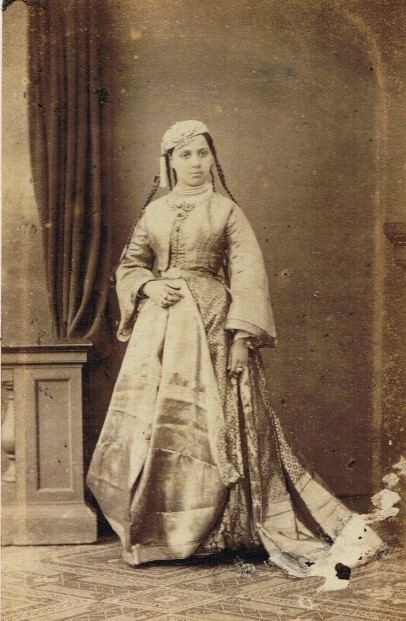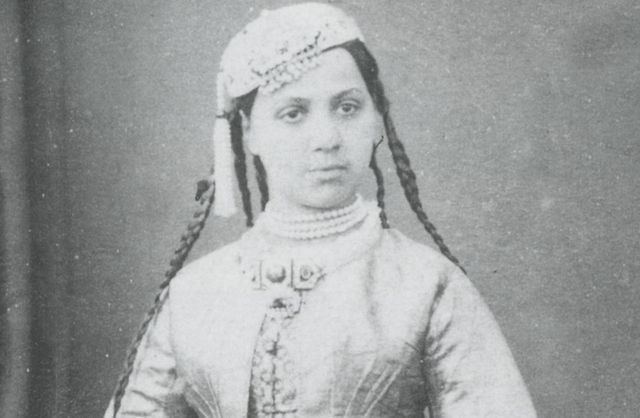Cause of death kidney failure Title Maharanee Role Duleep Singh's wife Children Bamba Sutherland | Known for a modern "Cinderella" Name Bamba Muller Marriage location Alexandria, Egypt | |
 | ||
Born July 6, 1848 Cairo Parent(s) Ludwig Muller and Sophia Died September 18, 1887, Paris, France Spouse Duleep Singh (m. 1864–1887) Education Presbyterian World Mission Similar People Duleep Singh, Bamba Sutherland, Victor Duleep Singh, Jind Kaur, Sophia Duleep Singh | ||
Bamba Muller & Bamba Sutherland
Maharani Bamba Duleep Singh (born Bamba Muller; July 6, 1848 – September 18, 1887) was the wife of Maharaja Duleep Singh. Brought up by Christian missionaries, she married Duleep Singh and became Maharani Bamba, wife of the last Maharaja of Lahore. Her transformation from illegitimate girl living in a Cairo mission to a Maharani living a life of luxury with the "Black Prince of Perthshire" has been compared to the "Cinderella" story.
Contents
- Bamba Muller Bamba Sutherland
- On this day 153 years ago Maharaja Duleep Singh married Bamba Mller
- Life
- The Prince
- The proposal
- Family
- References
On this day, 153 years ago, Maharaja Duleep Singh married Bamba Müller
Life

Bamba Muller was the daughter of Ludwig Muller, a German merchant banker with the company Todd Muller and Co., by his mistress of Abyssinian descent called Sofia. The name Bamba was Arabic for pink. Her father already had a wife and he therefore placed his illegitimate daughter in the care of missionaries in Cairo. Her father had requested and paid for her education and he was still in contact with the missionaries. Muller became an enthusiastic and charismatic member of the Christian community and was the only female in a select group of communicants at the American Presbyterian Mission school in Cairo.

The Prince
Duleep Singh had been the last ruler of the Sikh empire before he was dethroned by the British. In 1863 he was being supervised in Britain where he was a friend of Queen Victoria. He was known as the "Black Prince of Perthshire" around his home in Scotland. He was given money by the East India Company on condition that he complied with the will of the British Government. Duleep had been taken to Britain when a child and raised as a Christian. This was after he had been persuaded to agree to British rule of the Punjab. He had also been tricked to give away the Koh-i-Nor diamond and been separated from his mother, Maharani Jindan Kaur. His mother suffered a poor life in India and eventually she was allowed to rejoin her son in England. Duleep collected her after special permission was given. Duleep was allowed by the British to visit India for the second time to bury his mother after she died in Britain, although the body had to remain at Kensal Green Cemetery for nearly a year whilst this was agreed. His mother's ashes were not allowed to be buried in Lahore (the main city of the Punjab), but had to be placed in a memorial in Bombay.
The proposal
On his return from Bombay Duleep passed through Cairo and visited the missionaries there on 10 February 1864. He visited again a few days later and was taken around the girls' school, where he first met Bamba Muller, who was an instructor. She was the only girl there who had committed herself to a Christian life. On each visit Duleep made presents to the mission of several hundreds of pounds.
Duleep Singh wrote to the teachers at the missionary school at the end of the month in the hope that they would recommend a wife for him as he was to live in Britain and he wanted a Christian wife of Eastern origin. Queen Victoria had told Duleep that he should marry an Indian princess who had been educated in England, but he desired a girl with less sophistication. The final proposal had to be done via an intermediary as Duleep did not speak Arabic, Muller's only language. The missionaries discussed this proposal with Muller. She was unsure whether to accept the proposal offered via the missionaries. Her first ambition was to rise to teach children in a missionary school. Her father was consulted but he left the choice to his daughter. Muller eventually made her decision after praying for guidance. She decided that the marriage was God's call for her to widen her ambitions. Singh made a substantial contribution of one thousand pounds to the school and married Muller on 7 June 1864 in the British Consulate in Alexandria, Egypt. The ceremony was described as brief, with few witnesses. Both of them wore European dress apart from Duleep, who wore a turban. Bamba wore simple jewellery including pearls. She had a short sleeved, moire, antique dress, orange blossoms in her hair, and a veil. The Prince made his vows in English, whilst Bamba spoke in Arabic.
Family

The couple had three sons and three daughters whom they brought up at Elveden Hall in Suffolk, England. Her six children were: Victor Albert Jay (1866–1918), Frederick Victor (1868–1926), Bamba Sophia Jindan (1869–1957), Catherina Hilda (1871–1942), Sophia Alexandrowna (1876–1948), and Albert Edward Alexander (1879–1893).
Victor and Frederick both joined the British Army whilst Frederick became a Fellow of the Society of Antiquaries of London. One of her daughters, Bamba Sophia Jindan, returned to Lahore as the wife of a Dr Sutherland. She was known as Princess Bamba Sutherland. The other two daughters were named Catherine and Sophia.
In 1886 her husband resolved to return to India. On his way there he was arrested in Aden and forced to return to Europe. Bamba died on September 18, 1887 and was buried at Elveden. Her husband went on to marry again in 1889 to Ada Douglas Wetherill and had two more children.
Her son Albert Edward Alexander Duleep Singh died aged thirteen in Hastings on May 1, 1893 and was buried next to his mother. When Bamba's husband died, his body has brought back to England and buried with his wife and son at Elveden.
